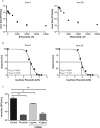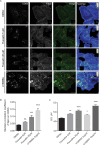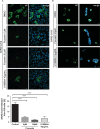Targeting the endolysosomal host-SARS-CoV-2 interface by clinically licensed functional inhibitors of acid sphingomyelinase (FIASMA) including the antidepressant fluoxetine
- PMID: 32975484
- PMCID: PMC7594754
- DOI: 10.1080/22221751.2020.1829082
Targeting the endolysosomal host-SARS-CoV-2 interface by clinically licensed functional inhibitors of acid sphingomyelinase (FIASMA) including the antidepressant fluoxetine
Abstract
The Coronavirus Disease 2019 (COVID-19) pandemic caused by the Severe Acute Respiratory Syndrome Related Coronavirus 2 (SARS-CoV-2) is a global health emergency. As only very limited therapeutic options are clinically available, there is an urgent need for the rapid development of safe, effective, and globally available pharmaceuticals that inhibit SARS-CoV-2 entry and ameliorate COVID-19 severity. In this study, we explored the use of small compounds acting on the homeostasis of the endolysosomal host-pathogen interface, to fight SARS-CoV-2 infection. We find that fluoxetine, a widely used antidepressant and a functional inhibitor of acid sphingomyelinase (FIASMA), efficiently inhibited the entry and propagation of SARS-CoV-2 in the cell culture model without cytotoxic effects and also exerted potent antiviral activity against two currently circulating influenza A virus subtypes, an effect which was also observed upon treatment with the FIASMAs amiodarone and imipramine. Mechanistically, fluoxetine induced both impaired endolysosomal acidification and the accumulation of cholesterol within the endosomes. As the FIASMA group consists of a large number of small compounds that are well-tolerated and widely used for a broad range of clinical applications, exploring these licensed pharmaceuticals may offer a variety of promising antivirals for host-directed therapy to counteract enveloped viruses, including SARS-CoV-2.
Keywords: FIASMA; IAV; SARS-CoV-2; endolysosomal interference; fluoxetine; viral entry.
Conflict of interest statement
No potential conflict of interest was reported by the author(s).
Figures





Similar articles
-
Pharmacologically induced endolysosomal cholesterol imbalance through clinically licensed drugs itraconazole and fluoxetine impairs Ebola virus infection in vitro.Emerg Microbes Infect. 2022 Dec;11(1):195-207. doi: 10.1080/22221751.2021.2020598. Emerg Microbes Infect. 2022. PMID: 34919035 Free PMC article.
-
Novel and potent inhibitors targeting DHODH are broad-spectrum antivirals against RNA viruses including newly-emerged coronavirus SARS-CoV-2.Protein Cell. 2020 Oct;11(10):723-739. doi: 10.1007/s13238-020-00768-w. Epub 2020 Aug 4. Protein Cell. 2020. PMID: 32754890 Free PMC article.
-
Design of Potent Membrane Fusion Inhibitors against SARS-CoV-2, an Emerging Coronavirus with High Fusogenic Activity.J Virol. 2020 Jul 1;94(14):e00635-20. doi: 10.1128/JVI.00635-20. Print 2020 Jul 1. J Virol. 2020. PMID: 32376627 Free PMC article.
-
The Novel Insight of SARS-CoV-2 Molecular Biology and Pathogenesis and Therapeutic Options.DNA Cell Biol. 2020 Oct;39(10):1741-1753. doi: 10.1089/dna.2020.5703. Epub 2020 Jul 21. DNA Cell Biol. 2020. PMID: 32716648 Review.
-
Targeting the sAC-Dependent cAMP Pool to Prevent SARS-Cov-2 Infection.Cells. 2020 Aug 25;9(9):1962. doi: 10.3390/cells9091962. Cells. 2020. PMID: 32854430 Free PMC article. Review.
Cited by
-
The Potential Protective Role of GS-441524, a Metabolite of the Prodrug Remdesivir, in Vaccine Breakthrough SARS-CoV-2 Infections.Intensive Care Res. 2022;2(3-4):49-60. doi: 10.1007/s44231-022-00021-4. Epub 2022 Nov 9. Intensive Care Res. 2022. PMID: 36407474 Free PMC article. Review.
-
The effect of antidepressants on the severity of COVID-19 in hospitalized patients: A systematic review and meta-analysis.PLoS One. 2022 Oct 6;17(10):e0267423. doi: 10.1371/journal.pone.0267423. eCollection 2022. PLoS One. 2022. PMID: 36201406 Free PMC article.
-
The interplay between inflammation and thrombosis in COVID-19: Mechanisms, therapeutic strategies, and challenges.Thromb Update. 2022 Aug;8:100117. doi: 10.1016/j.tru.2022.100117. Epub 2022 Jul 9. Thromb Update. 2022. PMID: 38620713 Free PMC article. Review.
-
Study on the clinical efficacy and safety of baloxavir marboxil tablets in the treatment of influenza A.Front Med (Lausanne). 2024 Apr 5;11:1339368. doi: 10.3389/fmed.2024.1339368. eCollection 2024. Front Med (Lausanne). 2024. PMID: 38646560 Free PMC article.
-
The effect of selective serotonin and norepinephrine reuptake inhibitors on clinical outcome of COVID-19 patients: A systematic review and meta-analysis.Health Sci Rep. 2022 Oct 17;5(6):e892. doi: 10.1002/hsr2.892. eCollection 2022 Nov. Health Sci Rep. 2022. PMID: 36268458 Free PMC article.
References
MeSH terms
Substances
Grants and funding
LinkOut - more resources
Full Text Sources
Other Literature Sources
Medical
Research Materials
Miscellaneous
